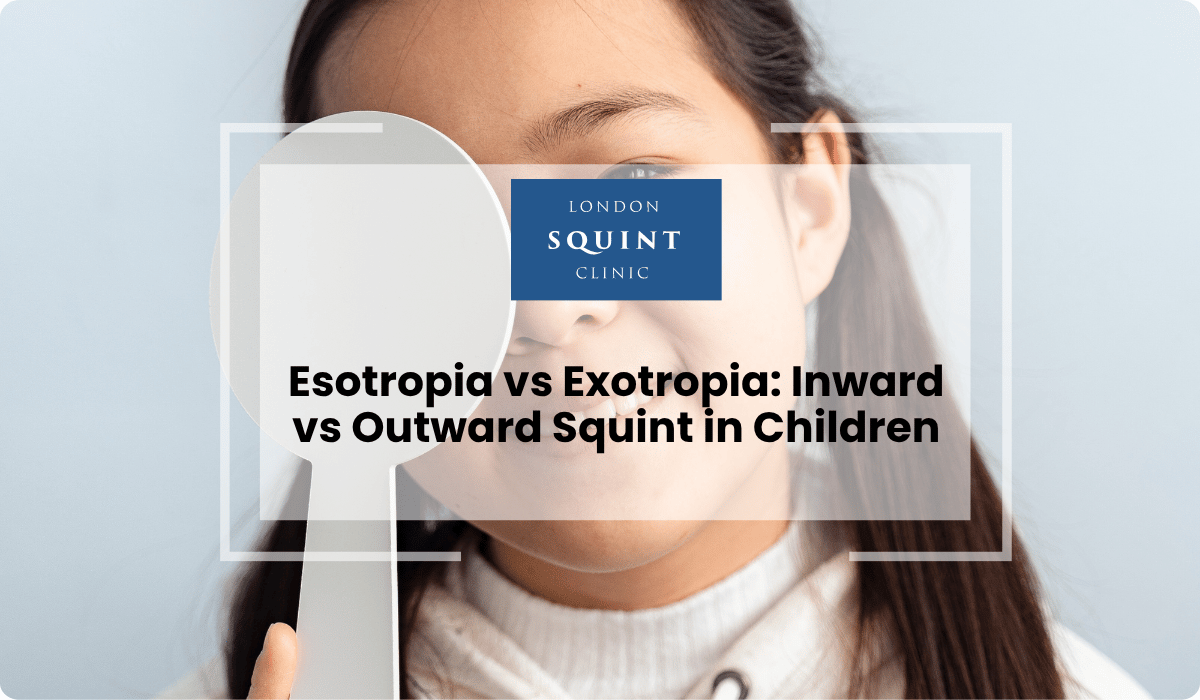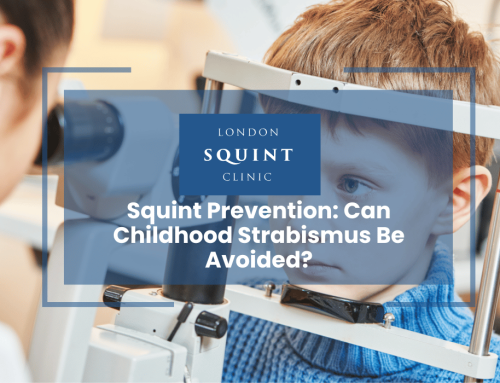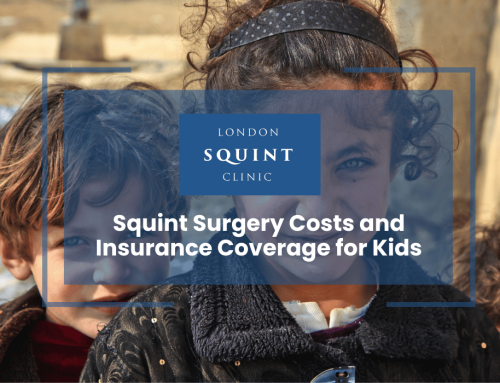Esotropia vs Exotropia: Inward vs Outward Squint in Children
Essential Insights: Understanding Your Child’s Squint
- Esotropia (inward squint) is more common in Western populations, while exotropia (outward squint) is more prevalent in East Asian children
- Early signs of esotropia include eyes turning inward and head tilting, while exotropia often presents as an outward eye drift when tired or daydreaming
- Accommodative esotropia is frequently caused by uncorrected long-sightedness and may respond well to glasses alone
- Treatment approaches differ significantly: esotropia often responds to glasses correction, while exotropia more commonly requires vision therapy or surgery
- Early intervention during critical periods of visual development (before age 8-10) offers the best chance for developing normal binocular vision
- Regular follow-up is essential for both conditions, as recurrence rates of 20-30% are reported within 5 years of treatment
Table of Contents
- Understanding Squint Types: Esotropia vs Exotropia Explained
- Recognizing the Signs: How Inward and Outward Squint Present
- What Causes Different Types of Squint in Children?
- Diagnosing Esotropia and Exotropia: The Assessment Process
- Treatment Approaches for Inward vs Outward Squint
- Which Type of Squint Is More Common in Children?
- Long-term Outlook: Visual Development and Squint Management
Understanding Squint Types: Esotropia vs Exotropia Explained
Squint (strabismus) is a common eye condition affecting approximately 2-4% of children in the UK. The condition occurs when the eyes point in different directions, with one eye looking straight ahead while the other turns inward, outward, upward, or downward. Two primary types of horizontal squint are esotropia and exotropia, which differ fundamentally in their presentation and management approaches.
Esotropia, also known as convergent squint or “crossed eyes,” occurs when one or both eyes turn inward toward the nose. This inward deviation can be constant or intermittent, and may affect one eye consistently (unilateral) or alternate between both eyes. Esotropia is particularly concerning in children as it can significantly impact binocular vision development during critical periods of visual maturation.
Conversely, exotropia, or divergent squint, presents when one eye turns outward away from the nose (sometimes called “wall eyes”). Like esotropia, exotropia can be constant or intermittent. Interestingly, intermittent exotropia often becomes more noticeable when children are tired, unwell, or daydreaming, and may initially present only when looking at distant objects.
Understanding the distinction between these two conditions is crucial for proper diagnosis and treatment planning. While both affect eye alignment, they often have different underlying causes, present at different ages, and may require distinct treatment approaches to achieve optimal visual outcomes for children.
Recognizing the Signs: How Inward and Outward Squint Present
Identifying the specific type of squint in children requires careful observation of several characteristic signs and symptoms. Parents and caregivers are often the first to notice these visual abnormalities, making their observations invaluable in early detection.
For esotropia (inward squint), the most obvious sign is one or both eyes turning inward toward the nose. Children with esotropia may develop a head turn to compensate for the misalignment, often tilting their head to the side opposite the turned eye. They might also close or cover one eye when focusing on near objects, particularly during reading or screen time. Infants with esotropia may demonstrate poor visual tracking of moving objects and may not establish proper eye contact.
Exotropia (outward squint) presents differently, with one eye drifting outward, especially when the child is tired, daydreaming, or looking at distant objects. Parents might notice their child squinting or closing one eye in bright sunlight—a characteristic sign of intermittent exotropia. Children with exotropia may also complain of double vision (diplopia) or demonstrate signs of eye strain such as rubbing their eyes frequently.
Both conditions can cause similar secondary symptoms, including:
- Poor depth perception, leading to clumsiness or difficulty with activities requiring hand-eye coordination
- Eye fatigue or headaches after visual tasks
- Difficulty maintaining focus on near objects
- Closing or covering one eye to see better
Early recognition of these signs is crucial, as prompt intervention during critical periods of visual development can significantly improve outcomes. If you notice any of these signs in your child, consulting with a pediatric ophthalmologist for a comprehensive assessment is essential.
What Causes Different Types of Squint in Children?
The underlying causes of esotropia and exotropia in children can vary significantly, involving complex interactions between neurological, anatomical, and refractive factors. Understanding these causes helps guide appropriate treatment strategies.
For esotropia (inward squint), common causes include:
- Accommodative esotropia: The most common form in children, triggered by uncorrected hyperopia (long-sightedness). When children with hyperopia focus to see clearly, they must accommodate excessively, which can trigger inward eye turning.
- Infantile esotropia: Appearing within the first six months of life, this form is not associated with refractive errors and may involve neurological factors affecting eye muscle control.
- Partially accommodative esotropia: A combination of refractive and non-refractive factors causing inward turning.
- Secondary esotropia: Resulting from poor vision in one eye (sensory esotropia) or following trauma or surgery.
For exotropia (outward squint), typical causes include:
- Intermittent exotropia: The most common form, often beginning as an occasional outward drift that becomes more frequent over time.
- Congenital exotropia: Present from birth, though rarer than congenital esotropia.
- Sensory exotropia: Developing secondary to poor vision in one eye.
- Consecutive exotropia: Occurring after surgical overcorrection of esotropia.
Several risk factors increase the likelihood of developing either type of squint:
- Family history of strabismus
- Significant refractive errors (hyperopia, myopia, or astigmatism)
- Premature birth
- Developmental disorders
- Neurological conditions affecting brain or cranial nerve function
Understanding the specific cause of a child’s squint is essential for developing an effective treatment plan that addresses the underlying factors rather than just the visible misalignment.
Diagnosing Esotropia and Exotropia: The Assessment Process
Accurate diagnosis of esotropia and exotropia requires a comprehensive ophthalmological assessment tailored to the child’s age and developmental stage. Pediatric ophthalmologists employ various specialised techniques to evaluate eye alignment, muscle function, and visual acuity.
The diagnostic process typically includes:
Visual acuity testing: Age-appropriate methods are used to assess how well each eye can see. For pre-verbal children, preferential looking tests or fixation preference techniques may be employed, while older children can use picture charts or letter charts.
Ocular alignment assessment: Several tests evaluate eye alignment, including:
- Hirschberg test: A penlight is shone into the eyes to observe corneal light reflexes
- Cover test: The examiner covers and uncovers each eye while observing for movement, the gold standard for diagnosing strabismus
- Prism cover test: Measures the precise angle of misalignment using prisms
Refractive error assessment: Cycloplegic refraction using eye drops to temporarily paralyse accommodation allows accurate measurement of any underlying refractive errors, particularly important in accommodative esotropia.
Ocular motility examination: Evaluates how well the eye muscles function in different gaze positions and can identify specific muscle weaknesses or overactions.
Binocular vision assessment: Tests stereopsis (depth perception) and fusion capabilities to determine how the eyes work together.
Comprehensive eye health examination: Includes assessment of the anterior and posterior segments of the eye to rule out any structural abnormalities.
The ophthalmologist will also gather a detailed history, including the onset and frequency of the squint, family history, developmental milestones, and any associated symptoms. This comprehensive approach ensures accurate diagnosis and classification of the specific type of squint, which is essential for developing an appropriate treatment plan tailored to the child’s needs.
Treatment Approaches for Inward vs Outward Squint
Treatment strategies for esotropia and exotropia differ significantly based on the underlying cause, severity, and the child’s age. The primary goals of treatment are to improve eye alignment, preserve or restore binocular vision, and prevent or treat amblyopia (lazy eye). A tailored approach is essential for optimal outcomes.
Treatment for Esotropia (Inward Squint):
- Glasses: For accommodative esotropia, prescribing glasses to correct hyperopia (long-sightedness) is often the first-line treatment. By reducing the need for excessive accommodation, the inward turning may resolve completely in some children.
- Patching therapy: If amblyopia is present, patching the stronger eye encourages use of the weaker eye, improving visual acuity.
- Prism glasses: These can help align images for children with smaller angles of esotropia.
- Eye muscle surgery: For non-accommodative or partially accommodative esotropia, surgical realignment of the eye muscles may be necessary. This typically involves tightening or repositioning specific extraocular muscles.
- Botulinum toxin injections: Sometimes used as an alternative to surgery or in very young children.
Treatment for Exotropia (Outward Squint):
- Observation: For intermittent exotropia that occurs infrequently, careful monitoring may be appropriate initially.
- Orthoptic exercises: Vision therapy exercises can help strengthen binocular control and fusion in intermittent exotropia.
- Patching: Sometimes used to treat associated amblyopia or as part of convergence training.
- Glasses: May be prescribed if significant refractive errors are present, though unlike esotropia, glasses alone rarely correct exotropia.
- Surgery: Often required for constant exotropia or progressive intermittent exotropia, involving adjustment of the lateral rectus muscles.
The timing of intervention is particularly crucial. Early treatment during critical periods of visual development (typically before age 8-10) offers the best chance for developing normal binocular vision. Regular follow-up assessments are essential to monitor progress and adjust treatment as needed, as both conditions can evolve over time.
A multidisciplinary approach involving ophthalmologists, orthoptists, and sometimes paediatric neurologists ensures comprehensive care, particularly for complex cases or those associated with developmental disorders.
Which Type of Squint Is More Common in Children?
Understanding the prevalence of different squint types helps clinicians and parents recognise patterns and risk factors. Epidemiological data consistently shows that esotropia (inward squint) is more common than exotropia (outward squint) in children in Western populations, though this pattern varies across different ethnic groups and geographical regions.
In the UK and most Western countries, esotropia accounts for approximately 60-70% of childhood strabismus cases, with accommodative esotropia being the most prevalent subtype. This form typically develops between 2-4 years of age and is strongly associated with uncorrected hyperopia (long-sightedness). Infantile esotropia, which appears within the first six months of life, represents about 8-10% of childhood strabismus cases.
Exotropia is less common in Western populations, accounting for approximately 20-25% of childhood strabismus cases. However, in East Asian populations, this pattern is reversed, with exotropia being the predominant form. Intermittent exotropia is the most common subtype, typically beginning between 1-4 years of age and often becoming more noticeable as the child grows.
Several demographic and risk factors influence the prevalence of different squint types:
- Gender differences: Some studies suggest a slightly higher prevalence of certain types of esotropia in females
- Premature birth: Associated with increased risk of all types of strabismus
- Family history: Children with a first-degree relative with strabismus have a 3-5 times higher risk
- Refractive errors: Significant hyperopia increases esotropia risk, while myopia may be associated with certain types of exotropia
- Neurodevelopmental conditions: Conditions like cerebral palsy and Down syndrome have higher rates of strabismus
Understanding these prevalence patterns helps clinicians maintain appropriate clinical suspicion during routine paediatric eye examinations, potentially leading to earlier detection and intervention for better visual outcomes.
Long-term Outlook: Visual Development and Squint Management
The long-term prognosis for children with esotropia or exotropia depends significantly on the type of squint, age at onset, timing of intervention, and adherence to treatment. Understanding the developmental trajectory helps parents and clinicians set realistic expectations and plan appropriate follow-up care.
For esotropia (inward squint), early intervention typically yields favourable outcomes. Children with accommodative esotropia who receive appropriate glasses prescription during the critical period of visual development often achieve excellent alignment and binocular function. Studies show that approximately 60-70% of these children maintain good alignment with glasses alone. However, about 30-40% may eventually require surgical intervention if a non-accommodative component develops.
Infantile esotropia generally requires surgical correction, with better outcomes associated with earlier intervention—ideally before 2 years of age. While surgery can achieve good cosmetic alignment, the development of high-grade stereopsis (fine depth perception) remains challenging, with only about 20-30% achieving this level of binocular function.
For exotropia (outward squint), the natural history often involves progression from intermittent to more constant deviation if left untreated. Following appropriate intervention, approximately 60-80% of children with intermittent exotropia achieve satisfactory alignment and functional binocular vision. However, recurrence rates of 20-30% are reported within 5 years of treatment, necessitating long-term monitoring.
Several factors influence long-term outcomes for both conditions:
- Presence and severity of amblyopia
- Age at intervention (earlier generally yields better results)
- Consistency with non-surgical treatments (glasses wear, patching)
- Presence of associated conditions (developmental delays, neurological issues)
- Complexity of the strabismus pattern
Long-term management typically involves regular follow-up examinations throughout childhood and adolescence, with frequency determined by the stability
Frequently Asked Questions
Is inward or outward squint more common in children?
Inward squint (esotropia) is more common in children in Western populations, accounting for approximately 60-70% of childhood strabismus cases. Accommodative esotropia, which typically develops between ages 2-4, is the most prevalent subtype. In contrast, outward squint (exotropia) accounts for only 20-25% of cases in Western countries, though it is more common in East Asian populations.
Can squint correct itself without treatment?
Most types of established squint (strabismus) will not correct themselves without intervention. While some newborns may have temporary misalignment that resolves by 3-4 months of age, persistent squint requires professional treatment. Intermittent exotropia may appear to come and go, but typically progresses without treatment. Early intervention during critical periods of visual development (before age 8-10) offers the best outcomes.
How can I tell if my child has esotropia or exotropia?
You can identify the type of squint by observing which way the eye turns:
– Esotropia (inward squint): One or both eyes turn toward the nose, creating a “cross-eyed” appearance
– Exotropia (outward squint): One eye turns outward away from the nose, especially when the child is tired or daydreaming
If you notice any eye misalignment that persists beyond 3-4 months of age, consult an eye specialist for proper diagnosis.
What happens if squint is left untreated in children?
Untreated squint can lead to several serious consequences:
– Amblyopia (lazy eye) development as the brain suppresses vision from the misaligned eye
– Permanent vision loss in the affected eye
– Poor depth perception and binocular vision
– Psychological and social impacts due to appearance concerns
– Progression of the condition, potentially making later treatment more difficult
Early intervention is crucial for optimal visual development.
Are glasses or surgery more effective for treating squint?
The effectiveness depends on the type of squint:
– For accommodative esotropia (inward squint caused by long-sightedness), glasses alone resolve the condition in 60-70% of cases
– Non-accommodative esotropia and most cases of exotropia typically require surgery
– Many children need a combination approach—glasses to address refractive errors followed by surgery for any remaining misalignment
Treatment is individualized based on the specific diagnosis, severity, and underlying causes.
Can children outgrow intermittent exotropia?
Children rarely outgrow intermittent exotropia. Without treatment, this condition typically progresses from occasional outward eye turning to more frequent and noticeable deviation. Studies show that approximately 75% of untreated cases worsen over time. While some cases may appear stable for periods, true spontaneous resolution is uncommon, making professional monitoring and timely intervention important.
At what age should squint be treated for the best outcome?
For optimal visual development, squint should be treated as early as possible:
– Infantile esotropia: Ideally before 2 years of age
– Accommodative esotropia: As soon as detected, typically between ages 2-4
– Exotropia: When it becomes frequent or constant, regardless of age
Early intervention during the critical period of visual development (before age 8-10) provides the best chance for developing normal binocular vision and preventing amblyopia.
Find out if you are suitable for Double Vision Treatment
Not everyone is eligible for double vision surgery.
Find out if you could benefit from this life-changing surgery by taking the quick self-suitability quiz below:
Our most popular procedures

Hello, I’m Nadeem Ali
I’m one of the few eye surgeons in the world with 100% focus on Squint and Double Vision Surgery.
I have 24 years of eye surgery experience, and worked for 13 years as a Consultant at London’s renowned Moorfields Eye Hospital.
In 2023, I left the NHS to focus fully on treating patients from across the world at the London Squint Clinic. You can read more about me here.
There’s lots of information on the website about: squint surgery, double vision surgery and our pricing.
The most rewarding part of my job is hearing patients tell me how squint or double vision surgery has changed their lives. You can hear these stories here.
Mr Nadeem Ali
MA MB BChir MRCOphth FRCSEd(Ophth)





